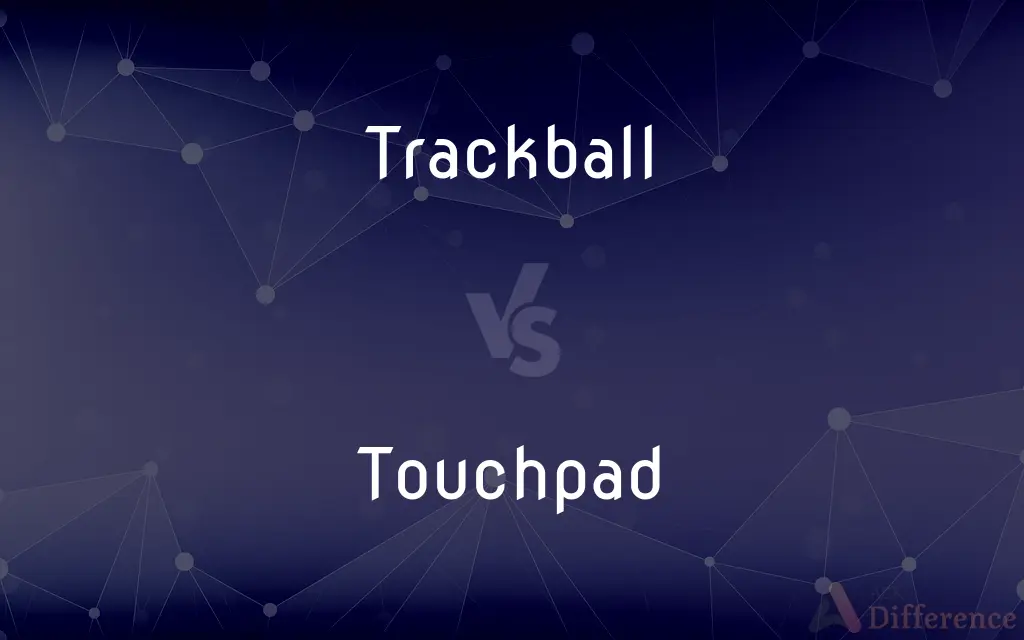Trackball vs. Touchpad — What's the Difference?
By Tayyaba Rehman & Urooj Arif — Updated on March 28, 2024
Trackballs offer precise cursor control with minimal hand movement, while touchpads provide multi-touch gestures but require more arm motion.

Difference Between Trackball and Touchpad
Table of Contents
ADVERTISEMENT
Key Differences
Trackballs feature a stationary ball that users rotate with their fingers or palm to move the cursor, minimizing the need for extensive hand and arm movement. This can be particularly beneficial in confined spaces or for those seeking ergonomic alternatives. Touchpads, on the other hand, detect the movement of fingers across their surface to navigate the cursor, supporting gestures like pinch-to-zoom and two-finger scrolling, thus offering a more intuitive experience for many users.
While trackballs are praised for their precision in cursor control, making them popular among professionals in design and gaming, touchpads are widely used in laptops for their compact, flat design that integrates seamlessly with the device. The touchpad's multi-touch capabilities allow for a variety of gestures that can enhance productivity and ease of use, whereas the trackball's design is focused on precise cursor movement and ergonomic benefits.
The ergonomic design of trackballs reduces the risk of repetitive strain injuries, as they require less wrist and arm movement than touchpads. This aspect makes trackballs a favored choice for users who spend long hours on their computers and are concerned about comfort and health. Conversely, touchpads, while convenient and ubiquitous in laptops, can contribute to discomfort over prolonged use due to the larger arm and wrist movements they necessitate.
Trackballs are less common than touchpads and can have a steeper learning curve for new users, who may find them initially unintuitive. However, once accustomed, users often appreciate the reduced physical effort and increased accuracy. Touchpads, being a standard feature on nearly all laptops, are familiar to most users, making them easy to use without a learning period, although mastering multi-touch gestures can enhance the user experience significantly.
Trackballs and touchpads cater to different user needs and preferences. Trackballs excel in providing ergonomic benefits and precise control, ideal for users engaged in detailed work or those with limited space. Touchpads, with their multi-touch functionality and widespread adoption, offer convenience and intuitive gestures for everyday computing tasks.
ADVERTISEMENT
Comparison Chart
Design Principle
Stationary device with a movable ball for cursor control.
Flat surface that detects finger movement.
Ergonomics
Minimizes wrist and arm movement, reducing strain.
Requires more wrist and arm movement.
Precision
High precision in cursor control.
Less precise compared to trackballs.
Learning Curve
May be unintuitive initially, but offers precise control once mastered.
Easy to use, with gestures enhancing functionality.
Common Use
Professional, design, and gaming environments.
Standard on laptops, suitable for general use.
Multi-touch Support
No multi-touch gestures.
Supports multi-touch gestures like scrolling and zooming.
Portability
Typically larger and less common in mobile devices.
Integrated into laptops, enhancing portability.
Health Benefits
Reduces risk of repetitive strain injuries.
Can contribute to strain with extensive use.
User Preference
Preferred by users needing precise control or ergonomic support.
Favored for convenience and intuitive use.
Compare with Definitions
Trackball
Rotating Ball Input Device.
She used a trackball to navigate her design software with precision.
Touchpad
Laptop Integrated Input Device.
The touchpad is seamlessly integrated below the laptop's keyboard.
Trackball
Alternative Input Method.
Gamers sometimes use a trackball for a unique control experience.
Touchpad
Portable Computing Navigation.
The absence of a mouse made the touchpad indispensable for her travel laptop.
Trackball
Stationary Mouse Alternative.
The trackball sits on the desk, eliminating the need for a mouse pad.
Touchpad
Gesture-based Control Surface.
She used pinch-to-zoom on the touchpad to enlarge the webpage text.
Trackball
Precision Navigation Tool.
Professional graphic designers often prefer a trackball for detailed work.
Touchpad
Multi-touch Gesture Support.
Using two fingers, she zoomed in on the image via the touchpad.
Trackball
Ergonomic Computer Peripheral.
His wrist pain diminished after switching to a trackball.
Touchpad
Finger-sensitive Input Surface.
He swiped his finger on the touchpad to scroll through the document.
Trackball
A trackball is a pointing device consisting of a ball held by a socket containing sensors to detect a rotation of the ball about two axes—like an upside-down mouse with an exposed protruding ball. Users roll the ball to position the on-screen pointer, using their thumb, fingers, or commonly the palm of the hand while using the fingertips to press the mouse buttons.
Touchpad
A touchpad or trackpad is a pointing device featuring a tactile sensor, a specialized surface that can translate the motion and position of a user's fingers to a relative position on the operating system that is made output to the screen. Touchpads are a common feature of laptop computers as opposed to using a mouse on a desktop, and are also used as a substitute for a mouse where desk space is scarce.
Trackball
A ball mounted in a stationary housing and rotated to control a pointer on a computer screen.
Touchpad
A pointing device consisting of a soft pad sensitized to finger movement or pressure and used especially on laptop computers as an alternative to a mouse.
Trackball
(computing) A pointing device consisting of a ball housed in a socket
Touchpad
(computing) A flat surface which is sensitive to touch, used mostly in laptop computers to control an on-screen cursor.
Trackball
An electronic device consisting of a rotatable ball in a housing; used to position the cursor and move images on a computer screen;
A trackball is essentially an upside-down mouse
Common Curiosities
Can you perform gestures on a trackball like on a touchpad?
While trackballs excel in precision, they generally do not support multi-touch gestures like those available on a touchpad.
Why might someone prefer a trackball over a touchpad?
Someone might prefer a trackball for its ergonomic benefits, precision in cursor control, or because it suits their workspace constraints.
What is a trackball?
A trackball is an input device featuring a stationary ball that users rotate to move the cursor, minimizing hand and arm movement.
How does a touchpad work?
A touchpad detects the movement and gestures of fingers across its surface to control the cursor and execute commands.
Is a touchpad suitable for professional design work?
While touchpads are versatile, professionals in design often prefer devices like trackballs or mice for greater precision.
How does the precision of a trackball compare to a traditional mouse?
Trackballs offer comparable precision to traditional mice, making them suitable for detailed tasks.
Are trackballs more ergonomic than touchpads?
Yes, trackballs are considered more ergonomic because they require less wrist and arm movement, reducing strain.
Do trackballs help with carpal tunnel syndrome?
Many users find that trackballs help reduce the risk of carpal tunnel syndrome due to their ergonomic design.
Are touchpads customizable?
Yes, touchpad settings can often be customized to adjust sensitivity, enable or disable gestures, and more.
Do all laptops come with a touchpad?
Nearly all modern laptops feature a touchpad as a standard input device.
Can touchpads be used for gaming?
While possible, touchpads are generally not preferred for gaming due to less precise control compared to mice or trackballs.
Which is more portable, a trackball or a touchpad?
Touchpads, being integrated into laptops, are more portable compared to the typically larger and standalone trackballs.
What are the health benefits of using a trackball?
The primary health benefit of using a trackball is the reduction in the risk of repetitive strain injuries from minimal wrist and arm movement.
How do I clean a trackball?
Cleaning a trackball involves removing the ball and wiping the internal components with a soft, damp cloth to remove dirt and grime.
Can touchpads recognize handwriting?
Some touchpads can recognize handwriting, although this feature depends on the specific device and its software.
Share Your Discovery

Previous Comparison
Pestilence vs. Conquest
Next Comparison
Foppish vs. DandyAuthor Spotlight
Written by
Tayyaba RehmanTayyaba Rehman is a distinguished writer, currently serving as a primary contributor to askdifference.com. As a researcher in semantics and etymology, Tayyaba's passion for the complexity of languages and their distinctions has found a perfect home on the platform. Tayyaba delves into the intricacies of language, distinguishing between commonly confused words and phrases, thereby providing clarity for readers worldwide.
Co-written by
Urooj ArifUrooj is a skilled content writer at Ask Difference, known for her exceptional ability to simplify complex topics into engaging and informative content. With a passion for research and a flair for clear, concise writing, she consistently delivers articles that resonate with our diverse audience.














































